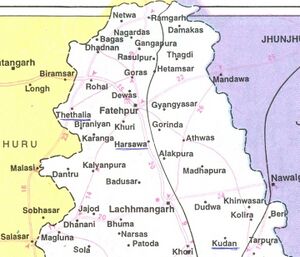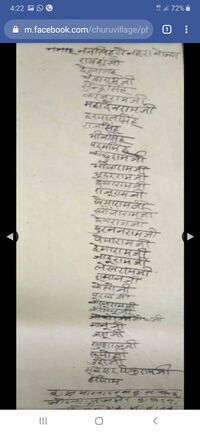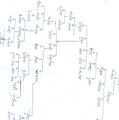Harsawa Bara
| Author:Laxman Burdak, IFS (R) |


Harsawa Bara (हरसावा बड़ा) or Harsāwā is a village located in Sikar district of Shekhawati region in Rajasthan state, India.
Location
It lies within the Fatehpur Tehsil in the south direction of Fatehpur town at a distance of 8 km on National Highway-11. Sand dunes of Thar Desert can be seen in Harsawa.
The founder
- Harsa Nehra founded the village Harsawa in 1287 AD.
- विक्रम संवत 1444 (=1387 ई.) में देवाराम गांव हरसावा आए.
Jat Gotras
- Nehra - Came from Hisar → Narhar → Deorod → Bajaur → Banthod → Harsawa
- Dhaka - Came from Juliasar and Datujala
- Lamoria - Came from Antroli
- Thori - Came from Ramsisar
- Bhaskar - Came from Rajas
- Dhayal - Came from Fuskani
About ninety percent of the population is of Jat caste. The Jat families include Nehra which is major clan, Dhaka, Lamoria, Thori, Bhaskar and Dhayal clans. The other castes include Rajputs, Brahmans, Swami, Harijans, Naik and Jangir.
Population
As of the Census-2001, there were 1695 people. Out of them, 829 were male and 866 were female. Literacy percentage in the village was 81.17%.
As per Census-2011 statistics, Harsawa Bara village has the total population of 1883 (of which 928 are males while 955 are females).[1]
History
After the defeat of last Hindu King of Delhi Prithviraj Chauhan, in the second Battle of Tarain in 1192, The Jats in his army moved to the countryside and settled as cultivators at various places in India. Initially Saharan gotra Jats had come to this place and started temporary cultivation. After some time Saharan Jat left this place. The Nehra gotra Jats from nearby village Banthod migrated to this place and started cultivation. One of these Nehra gotra Jats was Harsa Nehra who founded the village Harsawa in 1287 AD.
Later on, Dhaka gotra Jats from Juliasar and Datujala villages, Thori gotra Jats from Ramsisar, Bhaskar gotra jats from Rajas, Lamoria gotra Jats from Antroli and Dhayal gotra Jats from Fuskani villages also settled in Harsawa.
Genealogy of Nehras of Harsawa
The following Genealogy of Nehras of Harsawa was told by Sultan Khan Mirasi (Dhadhi) of Harsawa to the author (Laxman Burdak) on 19 July 2015.
Narapala (Narhad) + Harpal → Harpal → Jhunjha (1664 – 1730) (Founded Jhunjhunu) → Dewa (Founded Dewlana pond) → Pala (married in Bhadiyas of Banthod) → Mana (Founded Manana johad) → Kheta → Ganga → Birma (12 sons) → Mukna → Dharma → Bhinwa → Magna → Chandra → Hardeo Singh Nehra (1925 – 1998)
फतेहपुर के समीप हरसावा गाँव में नेहरा गोत्र के लोग काफी संख्या में हैं. लेखक (लक्ष्मण बुरडक) की हरसावा में स्वर्गीय हरदेव सिंह नेहरा की पुत्री गोमती से सन 1970 में शादी हुई. दिनांक 19.07.2015 को लेखक के हरसावा प्रवास के दौरान हरसावा निवासी श्री सुलतान खां मिरासी (Mob: 9929263766) से मुलाक़ात हुई. श्री सुलतान खां मिरासी का परिवार प्रारंभ से नेहरा लोगों के साथ रहा है. श्री सुलतान खां मिरासी ने हरसावा के नेहरा गोत्र की वंशावली जबानी इस प्रकार बताई.
नरहड़ के राजा नरपाल नेहरा थे और उसके भाई हरपाल थे. हरपाल का क्षेत्र काटली नदी के उस पार था. हरपाल के पुत्र झुंझा (1664 – 1730) ने झुञ्झुणु बसाया. किन्हीं कारणों से हरपाल का नरपाल से मतभेद हो गया इसलिए हरपाल फतेहपुर के समीप हरसावा की तरफ प्रस्थान कर गए. हरसा नेहरा ने सन 1287 में हरसावा बसाया. झुंझा के पुत्र देवा, देवा के पुत्र पाला, पाला के पुत्र माना हुए.
पाला का ससुराल बांठोद गाँव में भड़िया जाटों में था. देवा के नाम से बांठोद में देवलाणु जोहड़ छोड़ा. माना के नाम से हरसावा में मानाणु जोहड़ छोड़ा, जहां आज स्कूल बनी है. माना के पुत्र खेता हुये और उनके पुत्र गांगा हुये. गांगा के 12 पुत्र थे जिनमें से बीरमा सरदार बने। बीरमा के पुत्र मुकना, मुकना के पुत्र धर्मा भींवा और उनके पुत्र मगना हुये. मगना के चंदरा और उनके पुत्र हरदेव सिंह नेहरा (1925 – 1998) हुये.
नरपाल नेहरा + हरपाल (नरहड़) → हरपाल → झुंझा (1664 – 1730) (झुञ्झुणु बसाया) → देवा → पाला → माना → खेता → गांगा (12 पुत्र) → बीरमा → मुकना → धर्मा → भींवा → मगना → चंदरा → हरदेव सिंह नेहरा (1925 – 1998)
झुंझा का जन्म ठाकुर देशराज द्वारा 1664 ई. में बताया गया है. झुंझा वास्तव में हरदेव सिंह से 12 पीढ़ी पहले हुए हैं. एक पीढ़ी का औसत काल 22 वर्ष मानें तो 1925 - 264 = 1661 में झुंझा का जन्म होना चाहिए जो सही बैठता है. इस प्रकार झुंझा के काल की पुष्टि होती है.
सुल्तान खां मीरासी ने हरसावा के सम्बन्ध में एक दोहा सुनाया जो इसके इतिहास के बारे में प्रकाश डालती है -
- सदा हरयो हरसावो, गांगावत को गाँव,
- बारां को ओ बीरमों, नेहरो खाट्यो नाँव।
हरसावा के नेहरा गोत्र की वंशावली
नोट - नेहरा गोत्र की वंशावली यह वंशावली बनवारी लाल नेहरा हरसावा (M: 94144 22772) द्वारा उपलब्ध कराई गई है. स्रोत: नन्दी राव पुत्र छोगा राव निवासी आसलपुर (Mob:9784607108)
नेहरा गोत्र का गौत्रचारा
- वंश: अग्नि
- शाखा: माधनिक
- गोत्र: वत्स
- जन्म स्थान: आबू,
- नदी: भार्गवी
- निशान: सफेद घोड़ा केवड़ो नगारो विजय-
- पूजा: आशापाला
- परवर-5 :भार्गव, चिमन, आपलयुवान, औख व जमदग्नि.
शुरू में राजा चौहान ने टंकारी का राज्य किया मौकावती नगरी पर राज्य किया. अजमेर नगर को राजा अजय पाल जी ने संवत 202 (=145 ई.) में बसाया, तारागढ़ किला बनवाया. राजा अजय पाल एक चक्रवती राजा हुए.
राजा माणिक राव को माता संभराय का वरदान हुआ, सांभर नमक पैदा हुआ. सांभर शहर बसाया संवत 777 (=720 ई.) की साल में. उनके लड़के लाखण राव हुये.
लाखण राव के 24 लड़के हुए और उनसे चौहानों की 24 शाखाएं प्रचलित हुई. लाखन सिंह के बेटे विजय राज के दो लड़के हुए- हरराज और भंवरराज. भंवरराज के सोमराज के बाहुकपाल. बाहुकपाल चौहान संघ में सम्मिलित हुए. संवत 1130 (=1073 ई.) में उनके लड़के नरपाल नेहरा हुए जिन्होने नेहरा गोत्र को प्रसिद्धि दिलवाई.
नरपाल नेहरा ने मकराना की धरती छोड़कर अपने नाम पर गांव नरड़ बसाया संवत 1172 (=1115 ई.) में. उनके लड़के दो हुए नगराज और उदय पाल. नगराज के बेटे हरपाल और मेव. हरपाल के छोटे भाई रायमल. हरपाल के हरदेव और बणबीर के जुगराज के रतन सिंह के खींवराज, कंवरपाल, कस्तूर. खींवराज के माधव सिंह के रिछपाल के गोपाल, रूपलाल और दुहड़. गोपाल के कालू के हांसू और बाढ़सिंह. हांसु ने संवत 1320 (1263 ई.) में हिसार बसाया .
हांसु के 14 लड़के हुये- 1. बड़े समुदर सिंह, 2. दुल सिंह, 3. चुण्डजी, 4. सोमसिंह, 5. बल्लू, 6. बुधपाल, 7. चोहिल, 8. भीव सिंह, 9. पदम सिंह, 10. माणक, 11. दे पाल, 12. लहरु, 13. काछु, 14. अमरथ सिंह. इनके नाम से 14 थाम्बा नेहरा जाटों के कहलाए. बादशाह गयासुद्दीन तुगलक (r. 1320-1325) से झगड़ा हुआ और झगड़े में राव हांसू वीरगति को प्राप्त हुए.
हिसार को छोड़कर हांसू के लड़कों ने गांव दहरोड़ बसाया.
1.बड़े समदर दहरोड से आकर गांव बाजोर में बस गए.
2.दुल सिंह के गांव बांठोद में बस गए व उनके वंशज फिर गांव हरसावा व नयाबास में बस गए. दुलसिंह के बेटे रणुराम और रड़मल हुये. रणु राम संवत 1370 (1313 ई.) में बांठोद आए. रणु राम के रावत के करणाराम के लोहडु, लाबू और लहरु राम हुये. लोहड़ू के धोलूराम के देव राम, रामू राम, दोराज और दूदू.
3.चुंडा राम के लड़के शहर पादु में बसे.
4.सोम सिंह के लड़के गांव लोदीपुर में बस गए.
5.बल्लू के लड़के गांव डसाना में बस गए.
6.बुधपाल के लड़कों ने गांव भूकाणा बसाया व दहरोड़ में रहे.
7.चोहिल ने गांव किठाना बसाया.
8.भीव सिंह के लड़कों ने गांव कोलशिया बसाया.
9.पदम सिंह के लड़के गांव नगली (?) में बस गए.
10. माणक के वंशज लांबा देवलास बस गए.
11. देपाल के वंशज गांव कांगणसर बस गए.
12.लहरू के वंशज ने गाँव कोलिया बसाया.
13. काछूजी वंशजों ने गांव सांवलोद बसाया.
14. अमरथ जी के एक लड़की हुई जिसने अपने नाम को प्रचलित रखने के लिए अपने पिता के सहयोग से गांव फोंगा बसाया जिनके वंशज फोगा जाट कहलाए. नहरा और फोगा जाटों में भाईचारे का संबंध है. इसलिए ही इन दोनों गोत्रों में अब तक कोई प्रकार की रिश्तेदारी नहीं हुई जो हिंदू धर्म की सामाजिक परंपरा के अनुसार उचित भी है.
गांव दहरोड में नवाब मोहम्मद खां के साथ झगड़ा हुआ. उसमें अपने भाइयों की मदद करते हुए दुदाराम ने अपने प्राणों को न्यौछावर कर दिया. इसके बाद विक्रम संवत 1444 (=1387 ई.) में देवाराम गांव हरसावा आए. गांव बांठोंद में रामू तथा देवाराम ने जौहड़ भी छोड़े जो अब भी मौजूद है. देवाराम के लड़के दो हुये - पाला राम और फेफा राम. पालाराम के बेटे मानाराम और नरसाराम हुये. मानाराम के दो लड़के हुए- बालाराम और खेताराम तथा लड़की साली बाई जो नेता राम जी गोदारा जालेऊ निवासी को ब्याही गई. उसने गाँव जालेऊ से उठकर गांव अलखपुरा बसाया.
संवत सौलह सौ (=1543 ई.) में मानाराम ने हरसावा में मानाणु जोहड़ छोडा जो गाँव के पश्चिम में है और वर्तमान में इसमें स्कूल बनी हुई है. मानाराम के लड़कों के आगे की विस्तृत पीढियां निम्न फेमिली ट्री के रूप में दी गयी हैं:
राजा अजय पाल (145 ई. अजमेर बसाया) → राजा माणिक राव (सांभर शहर बसाया -720 ई.)) → लाखण राव (24 लड़के हुए) → विजय राज → भंवरराज (+हरराज) → भंवरराज → सोमराज → बाहुकपाल (चौहान संघ में सम्मिलित हुए) → नरपाल नेहरा (1073 ई.) (मकराना की धरती छोड़कर अपने नाम पर गांव नरहड़ बसाया 1115 ई.) → नगराज (+उदयपाल) → हरपाल (+रायमल) → हरदेव → बणबीर → जुगराज → रतनसिंह → खींवराज (+कंवरपाल, कस्तूर) → माधव सिंह → रिछपाल → गोपाल (+रूपलाल, दुहड़) → कालू → हांसू (+बाढ़सिंह) (हांसु ने हिसार बसाया 1263 ई.) (हांसु के 14 लड़के हुये इनके नाम से 14 थाम्बा नेहरा जाटों के कहलाए और उनके वंशजों ने अनेक गाँव बसाए) → हांसु के लड़के दुलसिंह → रणु (+रड़मल) (रणु 1313 ई. में बांठोद आए) → रावत → करणा → लोहडु (+लाबू,लहरु) → धोलू → देवा (+रामू, दोराज, दूदा) (देवा गांव हरसावा आए 1387 ई., गांव बांठोद में रामू तथा देवा ने जौहड़ छोड़े) → पाला (+फेफा) → माना (+नरसा) (1543 ई. मानाणु जोड़ा छोड़ा) → खेता (+बाला) → गांगू (+खेमा, उदा) → बीरमा (+गोर्धन, भुदर) → मुकना (+डालू, जीवन, पूरण, बाधा) → धरमा (+अमरा, सेखो, ठाकुर) → भींवा (+खींवा, सरू) → मगना (+केसा, हीरा) → चंदरा (+गांगू, जोधा) → हरदेव सिंह नेहरा (1925 – 1998) → विद्याधर → धर्मपाल + अजय
नोट: नाम के साथ ब्रेकेट में + लगाकर लिखे गए नाम भईयों के हैं. ऊपर फेमिली ट्री के रूप में दी गयी वंशावली से अलग से रेखीय वंशावली बना सकते हैं.
हरसावा के नेहरा गोत्र की वंशावली में

हरसावा के नेहरा गोत्र की वंशावली में नरहड़/देवरोड़ के बसाये जाने का उल्लेख है. बाहुकपाल चौहान संघ में सम्मिलित हुए. संवत 1130 (=1073 ई.) में उनके लड़के नरपाल नेहरा हुए जिन्होने नेहरा गोत्र को प्रसिद्धि दिलवाई.
नरपाल नेहरा ने मकराना की धरती छोड़कर अपने नाम पर संवत 1172 (=1115 ई.) में गांव नरहड़ बसाया उनके लड़के दो हुए नगराज और उदय पाल. नगराज के बेटे हरपाल और मेव. हरपाल के छोटे भाई रायमल. हरपाल के हरदेव और बणबीर के जुगराज के रतन सिंह के खींवराज, कंवरपाल, कस्तूर. खींवराज के माधव सिंह के रिछपाल के गोपाल, रूपलाल और दुहड़. गोपाल के कालू के हांसू और बाढ़सिंह. हांसु नेहरा ने संवत 1320 (1263 ई.) में हिसार बसाया.
हांसु के 14 लड़के हुये- 1. बड़े समुदर सिंह, 2. दुल सिंह, 3. चुण्डजी, 4. सोमसिंह, 5. बल्लू, 6. बुधपाल, 7. चोहिल, 8. भीव सिंह, 9. पदम सिंह, 10. माणक, 11. दे पाल, 12. लहरु, 13. काछु, 14. अमरथ सिंह. इनके नाम से 14 थाम्बा नेहरा जाटों के कहलाए. बादशाह गयासुद्दीन तुगलक (r. 1320-1325) से झगड़ा हुआ और झगड़े में राव हांसू वीरगति को प्राप्त हुए.
हिसार को छोड़कर हांसू के लड़कों ने गांव दहरोड़ बसाया. कालांतर में प्रत्येक लड़के के वंशज विभिन्न गाँवों में जाकर बस गए.
2.दुल सिंह के गांव बांठोद में बस गए व उनके वंशज फिर गांव हरसावा व नयाबास में बस गए.
गांव दहरोड में नवाब मोहम्मद खां के साथ झगड़ा हुआ. उसमें अपने भाइयों की मदद करते हुए दुदाराम ने अपने प्राणों को न्यौछावर कर दिया. इसके बाद विक्रम संवत 1444 (=1387 ई.) में देवाराम गांव हरसावा आए. गांव बांठोंद में रामू तथा देवाराम ने जौहड़ भी छोड़े जो अब भी मौजूद है.
संवत सौलह सौ (=1543 ई.) में मानाराम ने हरसावा में मानाणु जोहड़ छोडा जो गाँव के पश्चिम में है और वर्तमान में इसमें स्कूल बनी हुई है.
Geography
Route Bikaner to Jaipur National Highway-11 passes through the village Harsawa. Harsawa is located at 27°55' North, 74°59' East. The railway line from Bikaner to Jaipur also passes through it. The total geographical area of the village is 4000 bigha.
The natural climatic conditions in the village are very harsh and extreme. The temperature ranges from sub-zero in winters to more than 50 °C in summers. The summers bring hot waves of air called "loo". The village lies in the Thar Desert region. Annual rainfall is very low, of the scale of 450 mm. The ground water in the village is hard and salty and as deep as 200 feet (60 m). The people in the region depend on rainwater for agriculture. The rainwater is stored in pucca tanks and used for drinking purposes. On an average, the region faces every third year as a dry year and every eighth year as a famine year. During famine years it becomes very difficult for the animals to survive for want of fodder and the cattle population goes down drastically.
Economy
The main occupation of the villgers is agriculture. There are 140 persons serving the Indian Army, Central and State Govts. About 110 people have gone to Arab countries for earning. 3 families of Dhadhi caste are engaged in music and have gone to Pakistan. Large number of people of the village work in Agricultural Research Station Fatehpur and Central Sheep Breeding Farm Fatehpur, which are located just adjoining the village.
Education
Harsawa is considered to be a progressive village of the region. Education in the village was started in 1934 with the cooperation of villagers. Hardev Singh Nehra started formal education in 1935 with the help of Birlas under ‘Varnacular’ scheme. The first Primary School was started by the state Govt. in 1949. Presently it has been upgraded to High School. Number of private schools is also.
Role in the abolition of Jagirs
Harsawa has played an important role in the abolition of Jagirs. Before independence the conditions of the farmers were worst. The farmers were exploited and oppressed by the Jagirdars during British Raj. They were deprived of fundamental rights. They were given inhuman treatment when the Jagirdars did not get cesses known as “lag” or “begar” in time, they were given hard punishments and their crops used to be destroyed. The farmers of Harsawa united against oppression of Jagirdars and stopped giving cesses. Chaudhari Motaram and 15 others of the village Harsawa were arrested by Raja of Sikar in 1935 and imprisoned for three months. Farmers, mainly the Jats, under the leadership of Hardev Singh Nehra joined ‘Sikar Jat-Kisan-Panchayat’ and ‘Jaipur Praja-Mandal’ along with the Shekhawati farmers. After a long struggle the farmers got rid of oppression and got the ownership rights over the land they were cultivating.
Religion
All people belong to Hindu religion. There is one temple of Hanumanji, one temple of Goddess Mavali and one than (a sacred place) of Gogaji. One temple is of Netnarsi.
Notable persons
- Hardeo Singh Nehra - Freedom fighter
- Chaudhari Motaram - Freedom fighter
Gallery
-
-
Rohida tree at Harsawa
-
View of a Bawri situated in beer in north of village Harsawa
-
Rajiv Gandhi in Harsawa, Sanjay Singh Nehra seen on left and Vidyadhar Nehra in right
External link
- Information on Harsawa Bara village - villageinfo.in website
- Geo Location of Harsawa Bara
- Google link for Harsawa
- Villages in the Fatehpur tehsil, Sikar district
- Delimtation Commission Report
- Geographic features around Harsāwa, in Rājasthān, India
References
Back to Jat Villages







